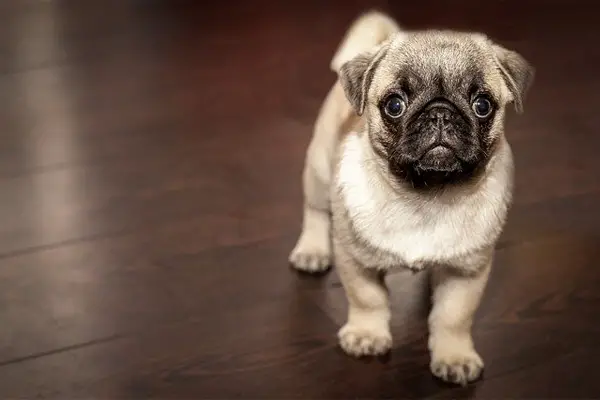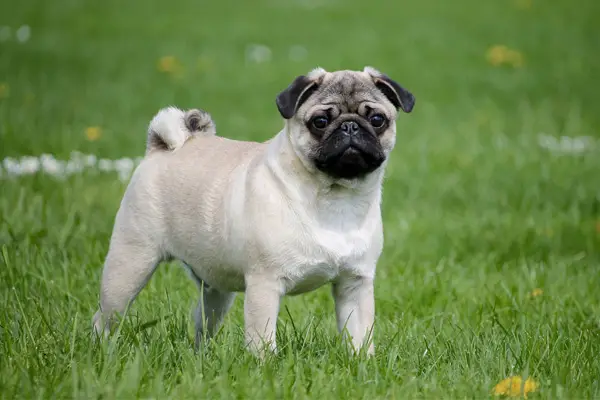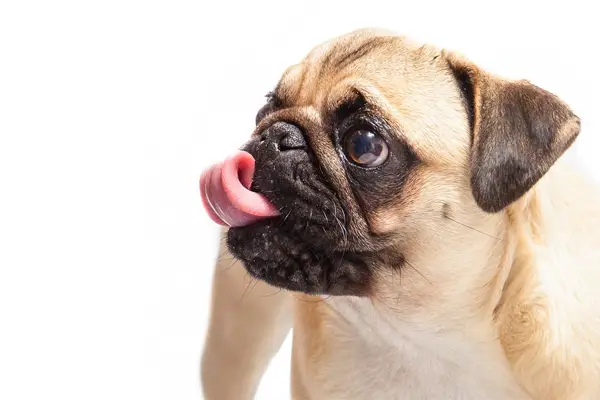
The Pug is a toy dog breed known for being the sturdiest among all toy dogs. They have a lot of personality inside a little body. Plus, they are known to be the clown of the dog’s world. Their charming face, featuring their deep wrinkles and round eyes, will make anyone who looks at them smile.
Since they were bred as lap dogs, these dogs thrive in human companionship. They perfectly fit in any home situation, whether you live in a city or a country, or whether you have kids or other pets. They are very affectionate dogs who love sleeping.
Pug Statistics
| Dog Breed Group | Toy Group |
| Height | 10-13 inches |
| Weight | 14-18 pounds |
| Lifespan | 13-15 years |
Pug Ratings
| Energy level | |
| Exercise needs | |
| Requires attention | |
| Playfulness | |
| Trainability | |
| Shedding | |
| Grooming | |
| Friendly with family | |
| Friendly with strangers | |
| Friendly with other dogs | |
| Prey Drive |
Pug History
The Pug is an ancient breed from China that existed way back to the Han Dynasty in 400 BC. During that time, Emperors of Ancient China loved flat-faced dogs, which includes the Pugs. They were pampered and treated like royalties with guards following them. They were treasures where outsiders can only receive as a gift.
For centuries, the Pugs remained hidden inside China’s Palace grounds. Well, they were until the late 1500s and early 1600s when China started trading with European countries.
When Dutch traders brought the first breed of Pugs, they immediately became popular. And just like in China, they were the favorites of the royal households. They even took part in some of the most critical events in history, such as saving the Prince of Orange from Spanish assassins.
Their popularity continued rising, especially in the Victorian Era. They were featured in paintings, postcards, and even figurines of the era. They were pictured as having large bows to create an image of nobility.
It was only after the US Civil War when the Pugs were brought to the US. The American Kennel Club recognized the breed in 1885. To this day, the Pugs continue to be one of the most popular dog breeds in the US, ranking 28th, according to the American Kennel Club.
Pug Temperament

The Pug’s temperaments vary from being playful to being calm. But, one fact always remains: Pugs are lap dogs. You certainly can’t expect them to guard, hunt, or retrieve. Instead, they do best as charming, mischievous, and loving family companions.
They are very friendly and peaceful with everyone, and that includes strangers and other animals. You can expect them to let out a bark when a visitor arrives. But, don’t worry, though, as they’ll still welcome them with snorts and grunts.
With his large expressive eyes, wrinkled forehead, flat-face, and undeniably innocent expression, you surely wouldn’t help but treat them like babies. Which, in fact, they are.
They have very child-like and clownish personalities that will surely make you laugh all the time. However, be very careful not to spoil them too much.
Puppy Pugs tend to be stubborn. But the adult ones are labeled to be couch potatoes who would love to sleep all day or sit on your lap.
If you want to ensure the best behavior, early socialization will always be the key. Meeting the parents will be very great too so you would know what temperaments might be present. This way, you’ll also be given guidance on how to handle these temperaments.
Pug Care Requirements
- Nutrition: It’s essential always to provide a dog, no matter what breed, a high-quality, well-balanced diet. With Pugs, in particular, it is crucial to monitor their daily calorie intake to avoid overfeeding. If they go overweight, they might find it more difficult to breathe. Caloric intake will usually depend on the age and activities your Pug is doing in a day. This is something you can discuss with your vet if you don’t have an idea how to calculate it. Between commercial and home-cooked diets, the latter is highly recommended. This is because you can control what specific ingredients you can put in or not, avoiding any allergies. Just remember, only provide high-quality ingredients. Animal protein is always the primary ingredient and must be the majority of the diet. You can also put in some carbohydrates such as brown rice or sweet potatoes. Additional fruits and vegetables also help in providing fiber. If you’re going for commercial dry or wet food, still make sure it contains high-quality ingredients. The primary component should always be animal protein. Avoid those that contain meat by-products, flavorings, and fillers as they are not healthy.
- Grooming: The Pugs have a short, smooth, and glossy coat that should be maintained. It regularly sheds, which means regular brushing is needed as well. Weekly brushing will usually do the trick in removing loose hair and reducing shedding, but if you can do it daily, why not? Besides, Pugs love human bonding, and it’s a great way to spend time with him. Bathing is done regularly. Since their indoor dogs that love to laze around, they don’t get dirty much. However, make sure to clean up their wrinkles regularly to avoid any dirt build-up that may cause skin allergies. Check their ears regularly too, and make sure to keep it clean. Their nails should be trimmed regularly as well. Even if they don’t need a lot of activities, long nails can still cause them pain.
- Exercise: Pugs are indeed couch potatoes. However, as the owner, it is your responsibility to give them a few minutes of exercise daily. Pugs are prone to obesity, which is why minimal exercise is highly needed. Two 20-minute walks in a day or a quick play session in the yard will do. Just make sure to observe symptoms of shortness of breath. If you notice him panting, it’s time to go home. You mustn’t over-exercise them. Also, avoid going out in hot weather conditions as this may cause difficulty in breathing as well.
- Health: Pug Dog Encephalitis and Canine Hip Dysplasia are two major diseases that Pugs are prone to. Minor health issues they’re prone to include elongated palate, patellar luxation, stenotic nares, Legg-Perthes disease, entropion, hemivertebra, obesity, and skin infections. Watch out for rare diseases he might also be affected with, such as allergies, seizures, and nerve degeneration. As some of these diseases are genetically transferred, seeing the parents is highly recommended. For conditions with available screening tests, you can have your dog take those as well.
- Lifespan: The life expectancy of Pugs is 13-15 years.

Famous Pugs
- Lamb and Moss: Stolen Pugs from China’s Emperor Palace
- Click: Offspring of Lamb and Moss; Forefather of the Pug Line
- Pompey: Pug of Prince William of Holland who warned him about Spaniards’ presence during the war of Spain
- Basco: Favorite Pug of Queen Elizabeth II
- Bully, Olga, Pedro, Minka, Fatima, and Venus: Queen Victoria’s Pugs
- Jack: The first black Pug
- Mops: The Pug of the queen of France, Marie-Antoinette
- Fortune: Pug of Napoleon Bonaparte’s wife, Josephine; he was also the only one allowed to visit Josephine during her imprisonment, and became the messenger of secret messages for her husband
- Punch and Missy: Harriet Beecher’s Pugs
- Oliver: Pug owned by Valentino, the greatest Italian designer
- Chester Ludlow: The Pug with a graduate degree from Rochville University
Fun Facts About Pugs
- The Pug is an ancient breed existing way back to 400 BC in Tibetan monasteries.
- They were initially called “losze” by Tibetan monks.
- The wrinkles on their forehead were meant to resemble the Chinese Character for “Prince.”
- They were pampered pets of the Emperors of China.
- You call a group of Pugs “Grumble.”
- The Pug is the official breed of the House of Orange. This is after one Pug saved the Prince of Orange, William the Silent, from Spanish assassins.
- There is a secret organization named the “Order of the Pug” formed by Roman Catholics in 1740.
- They’re not excellent swimmers, but they do love sleeping.
The post Pug appeared first on Furry Friends Gear.

No comments:
Post a Comment